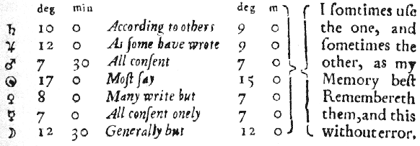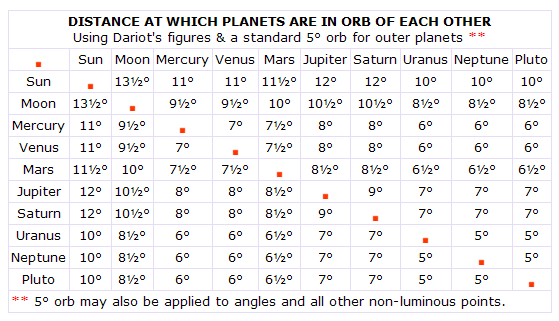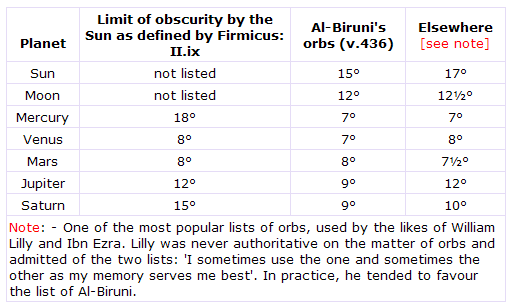You are using an out of date browser. It may not display this or other websites correctly.
You should upgrade or use an alternative browser.
You should upgrade or use an alternative browser.
Personal Frustration with Orbs
- Thread starter Inquirer
- Start date
Didn't say why you're feeling "frustration" so don't know whether widening orbs even beyond what a lot people consider too wide (e.g., 6-ish degrees) would solve your frustration.
Perhaps you've one of those charts where hardly any aspects show up with narrower orbs...? (then, a different solution would be to add-in minor aspects).
Just to say:
-I've noticed, e.g., one degree trines being more influential than 2 degree trines; and
-the narrower I go, the more accurately repeatable (with others' charts) my conclusions become.
Perhaps you've one of those charts where hardly any aspects show up with narrower orbs...? (then, a different solution would be to add-in minor aspects).
Just to say:
-I've noticed, e.g., one degree trines being more influential than 2 degree trines; and
-the narrower I go, the more accurately repeatable (with others' charts) my conclusions become.
Didn't say why you're feeling "frustration" so don't know whether widening orbs even beyond what a lot people consider too wide (e.g., 6-ish degrees) would solve your frustration.
Perhaps you've one of those charts where hardly any aspects show up with narrower orbs...? (then, a different solution would be to add-in minor aspects).
Just to say:
-I've noticed, e.g., one degree trines being more influential than 2 degree trines; and
-the narrower I go, the more accurately repeatable (with others' charts) my conclusions become.
I'm just curious as to whether a conjunction, say, between 8-10 degrees is legitimate.
Even squares, for instance, I have an orb of mercury square saturn at around 7.51 degree orb. In some charts, they don't even recongize this as an aspect, which I find strange because I relate to a lot of the characteristics that mercury square saturn has. In fact, I think it is my most powerful aspect to my mercury.
Even the Venus square saturn at an almost exact degree. Even though I do relate to the effects of it, I strangely do not as much as mercury square saturn.
JUPITERASC
Well-known member
FREE ONLINE STUDY AIDI'm just curious as to whether a conjunction, say, between 8-10 degrees is legitimate.
Even squares, for instance, I have an orb of mercury square saturn at around 7.51 degree orb. In some charts, they don't even recongize this as an aspect, which I find strange because I relate to a lot of the characteristics that mercury square saturn has. In fact, I think it is my most powerful aspect to my mercury.
Even the Venus square saturn at an almost exact degree. Even though I do relate to the effects of it, I strangely do not as much as mercury square saturn.
ORB TABLE http://www.skyscript.co.uk/aspectorbs.html

IMO, the whole issue with orbs uses a one size fits all process which is horribly simplistic.
The assumption is that because the sun and moon are both Lights then they will be able to have a bigger orb that Pluto and Mercury.
However, I don't find this the case at all. In practice, and again IMO, it depends on the characteristics of the individual planets in the individual chart. If the sun has no power and is pretty well neutral id effect then its orb tends to be smaller.
We call complain about how we have to look at the individual chart, but when it comes to orbs then suddenly that all gets thrown out the window and its back to one size fits all.
I just don't agree.
The assumption is that because the sun and moon are both Lights then they will be able to have a bigger orb that Pluto and Mercury.
However, I don't find this the case at all. In practice, and again IMO, it depends on the characteristics of the individual planets in the individual chart. If the sun has no power and is pretty well neutral id effect then its orb tends to be smaller.
We call complain about how we have to look at the individual chart, but when it comes to orbs then suddenly that all gets thrown out the window and its back to one size fits all.
I just don't agree.
StillOne
Well-known member
Interestingly, Liz Greene tends to use wide orbs. (Second set listed at the bottom) http://www.astro.com/astrology/in_aspect_e.htm
I'm finding her Psych Horoscope extremely informative. Probably the best reading I've ever had and to top it all off, it's a computer generated report!
I'm finding her Psych Horoscope extremely informative. Probably the best reading I've ever had and to top it all off, it's a computer generated report!

Alice McDermott
Well-known member
Until our first Saturn square Saturn around the age of 7, our unconscious is wide open to programming as our conscious, discriminating mind hasn't fully developed. This is the period when experiences for our life are programmed into our psyche.
So aspects within that 6-7 degree orb are far, far stronger than any beyond that as they are activated by Solar Arc and Secondary Progression, and sometimes transits, before the first Saturn square Saturn.
One of the first things I do when reading a chart is to see when the first Saturn square Saturn occurs and pay great attention to all planets that are activated before that as I know these are the areas where unconscious motivation is the strongest. The closer planets are in aspect the earlier in life they are activated and therefore have a much more profound influence.
Wider orbs can have some influence, particularly if they are also being activated by outer planet transits at the time they come into exact orb by Solar Arc or Secondary Progression. So if you feel your 7.51 degree orb of Mercury square Saturn is operative, then look at what happened in your life when you were 7-8 and what transits were energising either Mercury or Saturn at that time; if this 'double whammy' occurred it would have a big impact on you regardless.
In addition, some people don't have their first Saturn square Saturn until they are 8 years old, so, if this was the case for you then your major orb for aspects will be 8 degrees. Mine occurred when I was six (which was a huge year for me) so I don't allow any orbs over six degrees for my Ptolemaic aspects.
Alice
So aspects within that 6-7 degree orb are far, far stronger than any beyond that as they are activated by Solar Arc and Secondary Progression, and sometimes transits, before the first Saturn square Saturn.
One of the first things I do when reading a chart is to see when the first Saturn square Saturn occurs and pay great attention to all planets that are activated before that as I know these are the areas where unconscious motivation is the strongest. The closer planets are in aspect the earlier in life they are activated and therefore have a much more profound influence.
Wider orbs can have some influence, particularly if they are also being activated by outer planet transits at the time they come into exact orb by Solar Arc or Secondary Progression. So if you feel your 7.51 degree orb of Mercury square Saturn is operative, then look at what happened in your life when you were 7-8 and what transits were energising either Mercury or Saturn at that time; if this 'double whammy' occurred it would have a big impact on you regardless.
In addition, some people don't have their first Saturn square Saturn until they are 8 years old, so, if this was the case for you then your major orb for aspects will be 8 degrees. Mine occurred when I was six (which was a huge year for me) so I don't allow any orbs over six degrees for my Ptolemaic aspects.
Alice
JUPITERASC
Well-known member
HELLENISTIC astrologers said that an aspect had to either
be exact by degree
or
at most have a 3º 'orb'
ADDITIONALLY
HELLENISTIC astrologers then also recognised
ASPECTS BY SIGN
so
for example
any planet in any AIR sign
aspects any planet in any other air sign by trine
and
for example
any planet in AQUARIUS
aspects any planet in Sagittarius by sextile
and aspects any planet in Aries by sextile
and so on
so
even if any planet in AQUARIUS for example
is at 29º of that sign
there is nevertheless
AN ASPECT BY SIGN
with any planet in either Sagittarius or Aries
even if that planet is at 2[FONT=Times New Roman, serif]º Sagittarius/Aries
[/FONT]
be exact by degree
or
at most have a 3º 'orb'

ADDITIONALLY
HELLENISTIC astrologers then also recognised
ASPECTS BY SIGN
so
for example
any planet in any AIR sign
aspects any planet in any other air sign by trine
and
for example
any planet in AQUARIUS
aspects any planet in Sagittarius by sextile
and aspects any planet in Aries by sextile
and so on
so
even if any planet in AQUARIUS for example
is at 29º of that sign
there is nevertheless
AN ASPECT BY SIGN
with any planet in either Sagittarius or Aries
even if that planet is at 2[FONT=Times New Roman, serif]º Sagittarius/Aries
[/FONT]
miquar
Well-known member
Its important to keep in mind that every planet is in aspect to every other planet in any given chart. And this applies even if relatively small orbs are used. Every function (planet) is part of the whole and cannot work independently of any other function.
So when we define a set of aspects and a set of orbs, we are drawing an arbitrary line between those planetary relationships which are experienced in a relatively immediate and compelling way by the native, and those which are not.
In any chart, Jupiter and Saturn must be balanced, regardless of whether or not they are within the designated orb of one of a particular set of aspects.
Liz Greene does use orbs which are unusually large by modern standards, using 10 degrees even for a trine - double the orb that most astrologers would consider for this 'soft' aspect. But she does note that aspects with closer orbs are more compelling, while those with wider orbs may need to be consciously cultivated to come to fruition. We can consciously cultivate a working relationship between any two planets, though.
Another point is that if we are looking at a traditional aspect with a very wide orb, while ignoring close higher harmonic aspects and midpoint contacts, then we may be using peripheral information in place of more fundamental information. This is why I am quite stingy with orbs, but usually have a quick look at the strongest factors in the higher harmonic charts and midpoint trees when doing a full reading.
I also think it is relevant when two planets are in the same sign, or signs of the same element or whatever, even if they don't form a traditional aspect.
So when we define a set of aspects and a set of orbs, we are drawing an arbitrary line between those planetary relationships which are experienced in a relatively immediate and compelling way by the native, and those which are not.
In any chart, Jupiter and Saturn must be balanced, regardless of whether or not they are within the designated orb of one of a particular set of aspects.
Liz Greene does use orbs which are unusually large by modern standards, using 10 degrees even for a trine - double the orb that most astrologers would consider for this 'soft' aspect. But she does note that aspects with closer orbs are more compelling, while those with wider orbs may need to be consciously cultivated to come to fruition. We can consciously cultivate a working relationship between any two planets, though.
Another point is that if we are looking at a traditional aspect with a very wide orb, while ignoring close higher harmonic aspects and midpoint contacts, then we may be using peripheral information in place of more fundamental information. This is why I am quite stingy with orbs, but usually have a quick look at the strongest factors in the higher harmonic charts and midpoint trees when doing a full reading.
I also think it is relevant when two planets are in the same sign, or signs of the same element or whatever, even if they don't form a traditional aspect.
Last edited:
Inquirer, I'd like to ask you a question.
You have Saturn square Mercury in your chart. Have you read the descriptions of this aspect? Do you think it applies to you? If it does, then your Saturn squares your Mercury.
My guess is that is sure does.
YOu get more accurate as you get more experienced. Ask questions of people for whom you are reading like the one I asked you. Most people are honest about this stuff when it's a one on one situation.
If someone is experiencing the aspect, and are "living the aspect" it will not be a secret.
If you show an actual chart (any chart of someone you're familiar with) we could be specific about what we mean.
GENERALLY: (and this does not necessarily work with stellia) Sun and Moon to all planets....approx 10 degrees. Most other aspects, especially if connected with angular houses, 7-8 degrees.
Semi sextiles, semi squares, inconjuncts, and other so called minor aspects operate within about 2 and 1/2
degrees. By the way, so called minor aspects are not really minor....they just operate within a tighter orb...some because they are highly personal and psychological and some because they are very powerful..as is the inconjunct. The inconjunct is a very defining and specific energy. and very difficult.
But this will make you feel better. IF something is TRUE in someone's life you will NOT have to rely upon ONE aspect to let you know this. If something is really true there will be many indications of this truth.
LIN
You have Saturn square Mercury in your chart. Have you read the descriptions of this aspect? Do you think it applies to you? If it does, then your Saturn squares your Mercury.
My guess is that is sure does.
YOu get more accurate as you get more experienced. Ask questions of people for whom you are reading like the one I asked you. Most people are honest about this stuff when it's a one on one situation.
If someone is experiencing the aspect, and are "living the aspect" it will not be a secret.
If you show an actual chart (any chart of someone you're familiar with) we could be specific about what we mean.
GENERALLY: (and this does not necessarily work with stellia) Sun and Moon to all planets....approx 10 degrees. Most other aspects, especially if connected with angular houses, 7-8 degrees.
Semi sextiles, semi squares, inconjuncts, and other so called minor aspects operate within about 2 and 1/2
degrees. By the way, so called minor aspects are not really minor....they just operate within a tighter orb...some because they are highly personal and psychological and some because they are very powerful..as is the inconjunct. The inconjunct is a very defining and specific energy. and very difficult.
But this will make you feel better. IF something is TRUE in someone's life you will NOT have to rely upon ONE aspect to let you know this. If something is really true there will be many indications of this truth.
LIN
Last edited:



